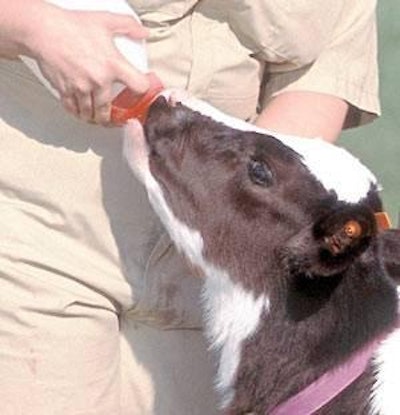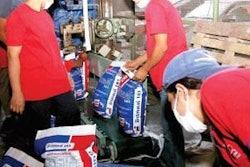
Veal calf production in European Union states and other countries faces a number of challenges. Animal welfare issues tend to predominate, but nutrition and health also can be problematic. In feeding veal calves, there is an on-going search to find consistently effective replacements for sub-therapeutic, growth-promoting antibiotics delivered through milk replacers.
A diverse Dutch research teamcomposed of university and feed industry scientistsrecently used a range of lactobacillus species to compare efficacy in growth promotion and feed efficiency in veal calves. The team included researchers with Utrecht University, Winclove Bio Industries, VanDrie Group, and Sloten, with H.M. Timmerman (formerly of Utrecht University's Department of Nutrition, Faculty of Veterinary Nutrition) as lead author of scientific reports published last year. The Dutch researchers took an innovative approach in contrasting performance in calves fed live microbial feed additives from very different sourcesa multispecies probiotic' (MSPB) containing different probiotic species of human origin, and a calf-specific probiotic' (CSPB) containing six Lactobacillus spp isolated from calf faeces and selected on the basis of a combination of characteristics.
Their series of experiments with 1-week-old veal calves assessed the influence of these direct-fed live microbials or probiotics on growth and health parameters. The researchers compared the MSPB and CSPB liquid supplements administered in milk replacers on a daily basis in both an all-in-all-out' production system as well as a grouped continuous flow' production system. Experimental periods were in the range of 1-15 days and 1-56 days.
When the data for the four experiments were pooled, the probiotics enhanced growth rate during the first weeks of production. During the 8-week experimental period, average daily gain and feed efficiency were significantly improved in the probiotic-treated groups. The MSPB-induced increase in weight gain was greater when the control calves were considered less healthy based on a health score, which was a frequency index of diarrhoea and therapeutic treatments. Also, probiotic treatment tended to reduce mortality in the calves.
Correlation of digestive and respiratory diseases
When therapeutic treatment with antibiotics was intensive in the control calves, the probiotics via milk replacer reduced the percentage of calves that required therapy and the number of treatments needed against both digestive and respiratory diseases. The researchers noted that the correlation of use of live, direct-fed microbials with reduction in antibiotic therapy against respiratory diseases first had been seen in human medicine; however, results in veal calves had not been reported previously. The Dutch researchers also found there was no clear difference in the efficiency of MSPB and CSPB preparations. They acknowledged that further research was necessary to identify underlying mechanisms. They recommended additional work to evaluate the potential of probiotics to improve respiratory health in veal calf production.
The researchers noted that diarrhoea is the main cause of morbidity and mortality in the early life of veal calves, and the first peak of respiratory diseases often emerges at 4 weeks of age, causing substantial economic losses due to medication and growth depression. A number of factors probably are involved in the high incidence of intestinal and respiratory disease: After birth, calves are separated from their mothers, which limits their ingestion of potentially protective gut flora, transported some distance, often co-mingled with other calves, and perhaps inadequately fed. The Dutch team reviewed the resulting health concerns, which included lower milk consumption, loss of barrier function of the gut, and possible impairment of immune function. They noted other research which found that the microbial gut flora of calves tends to decrease during this transition. Others had found that during stress events, protective lactobacilli tend to decrease while pathogenic coliforms tend to increase.
In the Netherlands, the conventional prophylactic technique had been to treat calves with antibiotics during the first 5 to 10 days after arrival on-farm. However, the Dutch researchers noted, the antibiotics diminished not only the activity of the pathogenic flora, but also that of the protective flora. Another factor, not discussed in the 2005 Dutch report, has been the impact of EU legislation and regulation restricting the use of sub-therapeutic levels of pharmaceutical-type antibiotics. With antibiotic growth promoters (AGPs) now banned from EU feeds since January, many animal producers may be relying to a greater extent on medicated products administered under veterinary prescription.
Lactobacillus versus diarrhoea
Different lactobacillus strains had been reported to offer antidiarrhoeal capability, the Dutch researchers noted. They reasoned that the combination of genera-specific probiotic properties should make the MSPB preparation superior to the traditional monostrain' probiotics. The CSPB preparation they used contained six Lactobacillus spp strains that were originally isolated from the target animal. They hypothesised that its calf-specificity' would enhance the ability of the CSPB to colonise the host animal, which should provide greater effects than the MSPB, because successful colonisation is one of the prerequisites for a probiotic to exert its beneficial activity. A major difference between this approach and others was that these Dutch researchers used fresh fermented probiotic cultures rather than freeze-dried preparations.
The MSPB preparation consisted of commercially available, freeze-dried probiotic strains of human originLactobacillus acidophilus W55, Lactobacillus salivarius W57, Lactobacillus paracasei spp. paracasei W56, Lactobacillus plantarum W59, Lactococcus lactis W58, and Enterococcus faecium W54all sourced from Winclove Bio Industries BV, based in Amsterdam. The CSPB formula contained strains isolated from veal calf digesta and faeces, for which lactobacillus strains were isolated from fresh faecal samples from healthy cattle and screened for probiotic properties. In preparing the liquid feed supplements, both MSPB and CSPB cultures were individually inoculated and grown in a liquid fermentation medium.
These Dutch trials used more than 400 Holstein-Friesan calves purchased in the local market and transported to the research farms of the VanDrie Group (all-in-all-out management) and Sloten BV (continuous flow management), and included antibiotics colistin and neomycin by milk replacer in the first week of transition. The complete results are available at https://www.journalofdairyscience.org/.
Countering compromised health status
In their discussion of results, the Dutch researchers noted that previous research seemed to show that probiotics (direct-fed, live microbial products) were most effective in recently transported calves and that the beneficial effects diminished over time, possibly because the calves "adapted to stressors such as transportation, new environment, change in diet, and infection pressure." In their studies, the researchers observed that the probiotic-induced improvement in growth during the first 8 weeks was negatively correlated with multiple factor index of general health status' (GHS). "Thus," the Dutch researchers suggested, "the positive effect of probiotics on growth performance of calves may only be present when their health status is compromised." They also suggested that this effect contributed to the tendency of probiotic treatment to reduce mortality, which had been shown in work by others in calves and other species.
"It is interesting to note," the Dutch researchers commented, "that treatment with CSPB significantly reduced mild diarrhoea, most probably of nutritional origin, whereas MSPB did not. However, MSPB significantly reduced therapeutic treatments against gastrointestinal disease. Perhaps the positive effect of MSPB against gastrointestinal disease is based on a different mechanism of action than that of CSPB."
The Dutch researchers also noted that other researchers had concluded that use of certain antibioticsparticularly neomycinresulted in diarrhoea and malabsorption in calves. However, they pointed out that doses used were very high compared with doses used in their work, while other work had shown that similar low inclusion rates of neomycin and oxytetracycline in the diet of veal calves resulted in improved faecal scores compared with untreated calves. "Whether the antibiotic treatments influenced the observed probiotic effects remains disputable. The growth-promoting effect during weeks 1 to 2 is more likely a consequence of reducing weight-loss induced by stress factors during this adaptation period. However, the antidiarrhoeal effect might be affected by the antibiotics used."
The Dutch research team said their results indicated that probiotics may reduce antibiotic use in veterinary practice, as other researchers had suggested, which in turn "might contribute to reducing microbial resistance against veterinary and human antibiotics."
Regarding the performance of CSPB versus MSPB, the Dutch researchers concluded that "the evidence for calf-specific bacteria colonising in calves efficiently is not strong." Previous work by members of the Dutch team, "pointed at the superiority of a multispecies probiotic compared with a multistrain probiotic."



.jpg?auto=format%2Ccompress&fit=crop&h=167&q=70&w=250)













